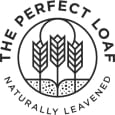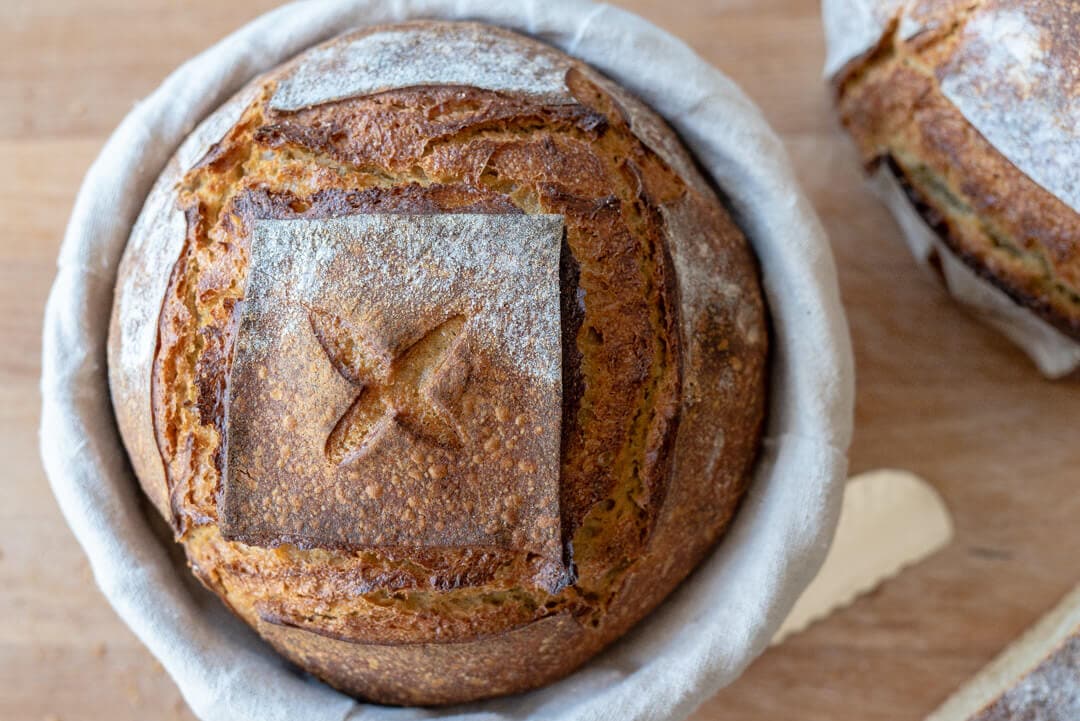These days it seems I seldom bake bread comprised of only a single flour. Usually, my mind busily weaves together a formula of different flours after I decide on an end goal. The end goal is my compass, dictating the direction as I work backward to make it happen: the flavor from this flour, this one is extra nutritious, add some extensibility with this one, perhaps a bit of color with this other, and maybe some added strength, if necessary. Lately, though, I’ve been focusing down on a formula comprised in total of ancient einkorn wheat flour. I’ve baked with einkorn many times in the past at less than one hundred percent of the total formula (and my einkorn miche is always my go-to for large dinners) but pushing the percentage of einkorn results in unique sourdough bread.
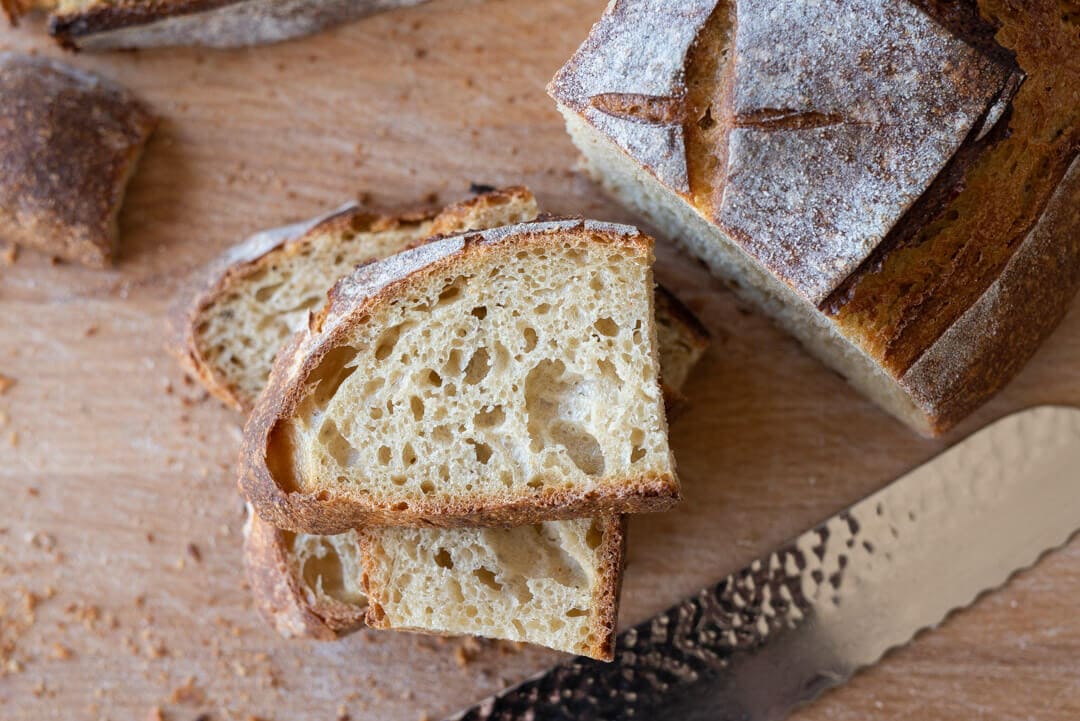
Out of the oven, this bread has a captivating crust: rustic fissures with golden undertones and hints of burgundy. The golden boules, as I like to call them, that have that perfect balance between tender interior and substantial, toothy exterior. The rich and tangy flavor pairs so well with a variety of foods. My favorite use, and right now in perfect seasonal timing, is to use it as a base for fresh chopped tomatoes, basil, extra virgin olive oil, and a dash of balsamic.
The warm—perhaps the best way to describe it—the flavor of the crumb stands up to and balances out, the acidity in the tomatoes and vinegar. It also makes some of the best toast with cultured butter and fresh preserves. The interior crumb of this bread stays moist for days after baking. The rich, warm flavor seems to even amplify as the bread ages a few days after baking. It’s one of those bread, like 100% fresh milled whole grain, where I like to let sit at least half a day (or even until the next day) before slicing. Although, I won’t blame you if you cut into it shortly after taking it out of the oven, a treat we all have to try at least once.
Let’s first discuss einkorn flour selection and then get into a few challenges I’ve discovered with this grain and my proposed solutions.
Einkorn Flour Selection
For this formula, I used Jovial’s organic all-purpose einkorn flour. Their flour has a beautiful creamy complexion, and it clumps readily in hand (indicating plenty of natural oils present). In working with their einkorn for my previous miche, I milled their whole berries just before mixing and included the resulting flour at 100% extraction (whole grain). For this bake, I wanted to push the percentage of einkorn flour and use all-purpose in an attempt at an all-einkorn hearth bread.
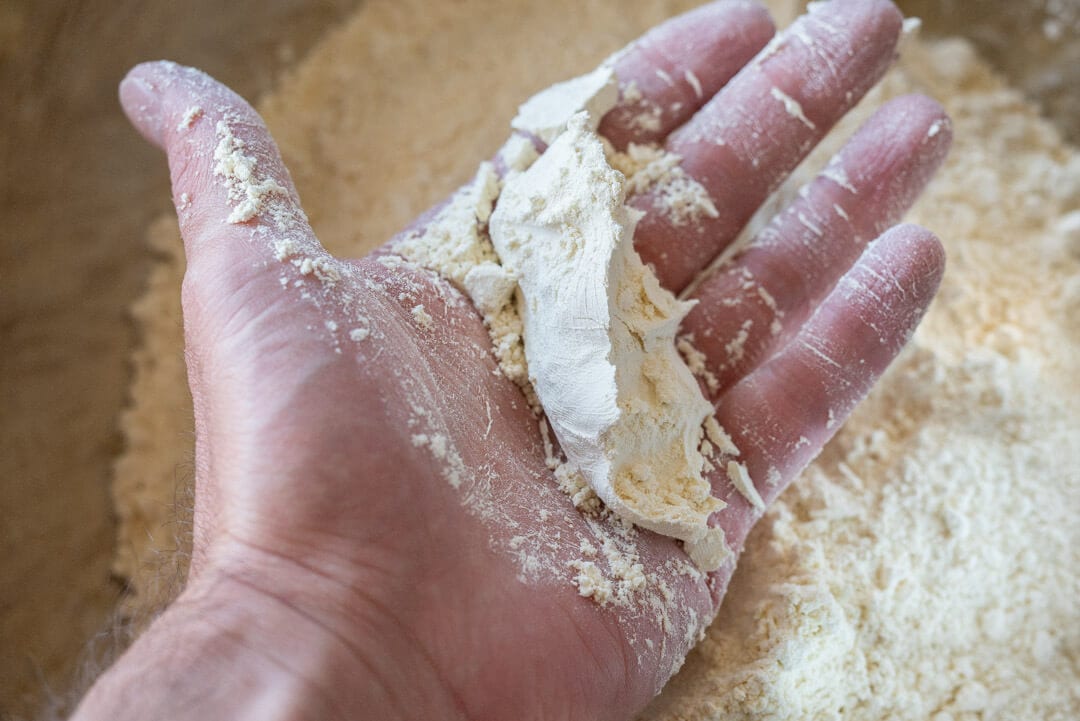
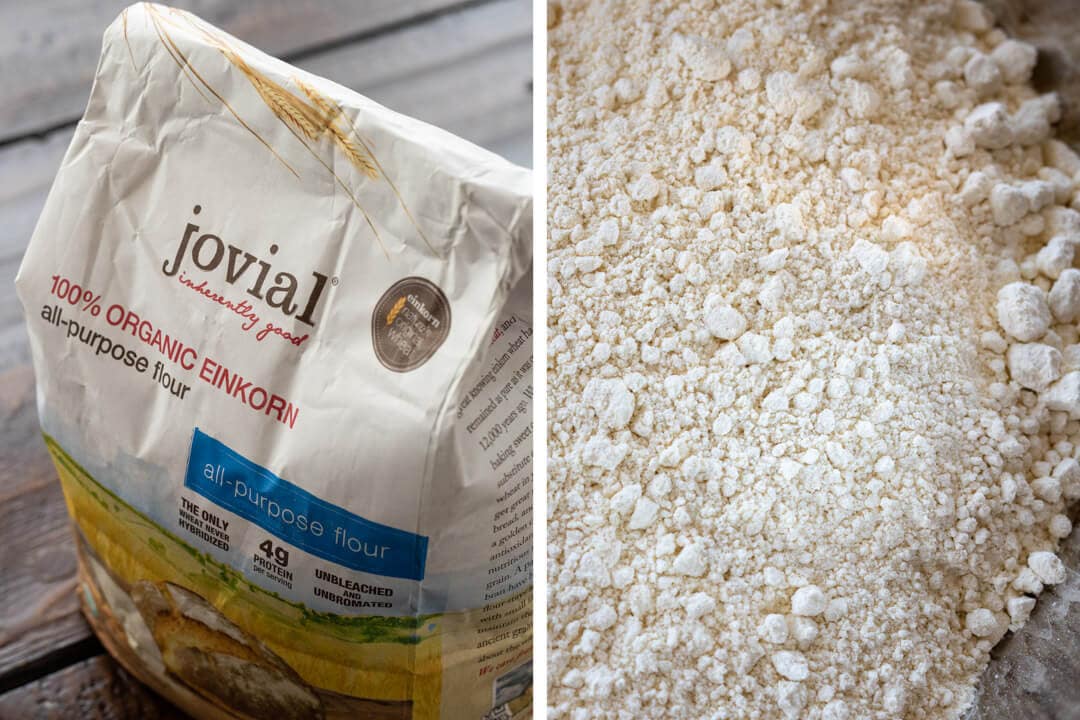
Upon mixing einkorn with water, you’ll notice it has a silky, smooth texture. It tends to break apart easily, feels sticky, and makes mixing by hand a little challenging. If you have a danish dough whisk and are accustom to using it, this might be a good time to take it out. Additionally, I’ve found it to be rather picky with hydration: if you push it too high, the dough will quickly become unusable. As I said above, be conservative with the water through mixing and only add it if the dough feels and looks like it’s able to take more. More on mixing and hydration in the next section.
Nutrition
Studies have shown there are health benefits to eating ancient einkorn wheat. In addition to being a good source of dietary protein and some vitamins (especially B vitamins and thiamine), einkorn has been shown to have higher carotenoid (antioxidant) levels, particularly lutein, also known as “the eye vitamin.” And while einkorn is high in protein, it’s gluten levels are relatively low. Thus some who are sensitive to modern wheat seem to do fine with einkorn sourdough bread (of course, each person is different. Einkorn does contain gluten, so it’s not suitable for those with Celiac disease).
For more einkorn nutrition information, including comparisons between einkorn and modern wheat, head over to Jovial’s website.
Einkorn Sourdough Bread Recipe
This dough formula would also make an excellent pan bread.
This recipe yields a relatively challenging dough to work with. However, the following section will discuss some of the observations I’ve made and techniques used when working with this grain. Additionally, and as always, feel free to adjust the timing and formula to align with your particular flour and comfort level.
My goal was to produce a hearth style loaf, but if you find the dough very slack and hard to handle, you can always use a bread pan to make sandwich bread. The structure of the pan will help keep the dough from spreading and make shaping much easier.
Observations and My Approach
Hydration
In my testing, I found the best results, regarding final taste and texture, with the dough at 75% hydration. While 75% hydration may not seem drastically high, always remember this number is directly related to the grain you’re using. In other words, the percentage doesn’t mean much taken out of context; it only becomes meaningful when compared to the flour you’re using (and perhaps even that particular batch of flour). Further, there is no point to increasing hydration if you don’t see a benefit from it — we don’t push the number to push the number. At 75% hydration, the dough is slack and sticky and requires a deft hand when preshaping and shaping.
If this is the first time you are working with einkorn at 100%, I’d suggest you start with 65-70% hydration and work it up through a few successful bakes, if desired.
Mixing
Mixing this dough by hand is challenging because of the sticky nature and low gluten properties of the grain. I found the best approach was to keep my very hands wet (using the mixing water, not adding more) through the mixing process. If you have a Danish dough whisk it might help aid mixing. I also avoid slap and fold kneading or any dough work on the counter — it’s done all in the bowl, relying on several additional sets of stretch and folds during the bulk to finish strengthening.
Pre-shaping and Shaping
Be sure to pre-shape and shape the dough tight using well-floured (or use water) hands. A tight pre-shape will help impart critical structure to the dough after dividing, setting the stage for a uniform and tight final shape. The dough should show its strength with defined edges when it’s placed in the proofing basket. I have more details, with a picture of the result, in the Shaping section below.
Fermentation Activity
I find this flour leads to an incredibly active dough. In testing, I ended up over proofing an early trial of this dough. To remedy this, I dialed back my levain percentage and employed a stiff levain to help. I would also avoid pushing the cold proof any further than 12-14 hours. Even though in a home fridge the dough is kept very cold at 38-39°F (3-4°C), the dough can quickly overproof.
Einkorn Sourdough Starter
To ensure this bread is truly 100% einkorn, you’ll have to convert your starter over to an all-einkorn sourdough starter if you don’t already maintain one. An alternative to this would be to create a second starter from your current one and feed it einkorn flour for a few days to convert it over. I’ve made this recipe with both a modern wheat starter (my typical sourdough starter) and also an all-einkorn 100% hydration variant—both work equally well.
Ok, on with the formula!
Vitals
| Total Dough Weight | 2000 grams |
| Pre-fermented Flour | 3.50% |
| Hydration | 75% |
| Yield | 2 x 1000g boules |
Einkorn Sourdough Levain
In testing this formula, I found the best performance, taste, and timetable when using a stiff einkorn levain. Even though the flour I’m using is sifted (all-purpose) and not whole grain, this dough can quickly overproof at warmer temperatures. To offset this I found myself gravitating to a stiff levain at a very low pre-fermented flour percentage. Mostly, I treated this all-purpose flour as I would whole grain.
At 100% inoculation (the percentage of ripe starter used to build the levain) my levain was ready to be mixed into the dough after 3 hours at 77-80°F (25-27°C).
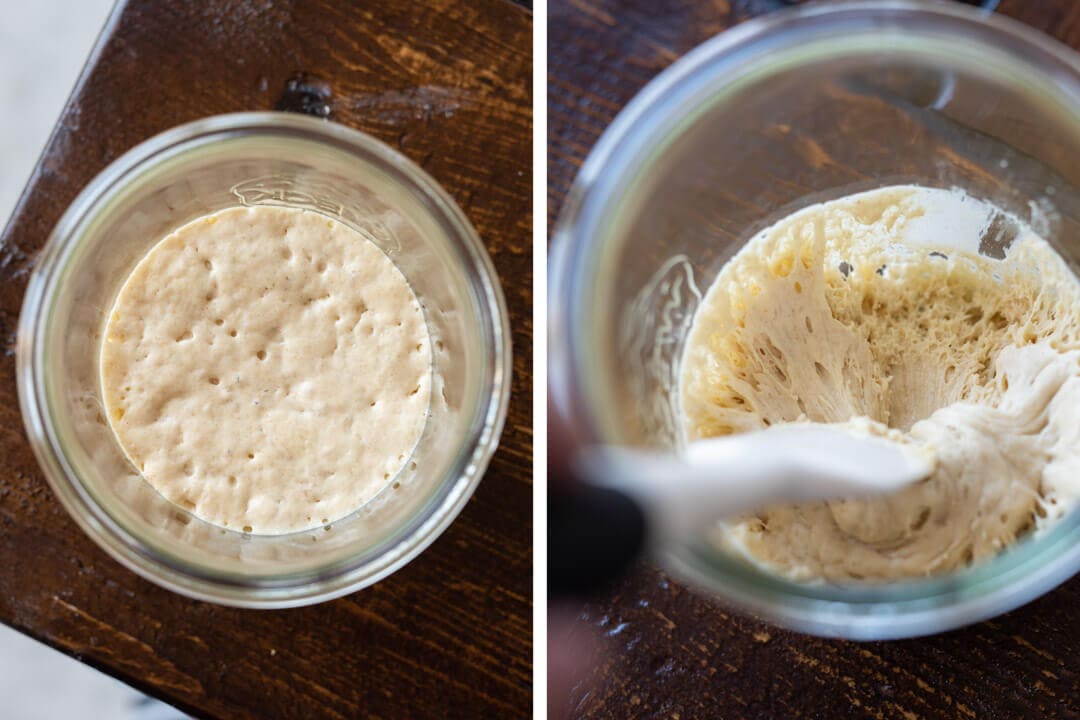
When assessing readiness, look for a leveling off of the “dome” that is created as this levain is ripening. Additionally, you’ll see significant aeration at the sides, and if you gently poke at the top, it’ll give readily under pressure. This levain is a fast build: it ripens from the first feeding to maturity in only 3 hours. The high inoculation percentage and warm temp expedite the timetable. If you’d like to lengthen this build to better fit your schedule, drop the inoculation down to 50% ripe starter and it’ll be ready around 5-6 hours.
| Weight | Ingredient | Baker’s Percentage |
|---|---|---|
| 39g | Ripe sourdough starter (100% hydration) | 100% |
| 39g | All-purpose einkorn flour (Jovial organic all-purpose einkorn) | 100% |
| 17g | Water | 45% |
Dough Formula
Target final dough temperature (FDT) is 76-77°F (24-25°C). For more information on final and desired dough temperatures, have a look at my guide to the importance of temperature in baking.
Note that the baker’s percentages listed below are with respect to the final dough ingredients and do not take into account the levain.
| Weight | Ingredient | Baker’s Percentage |
|---|---|---|
| 1066g | All-purpose einkorn flour (Jovial organic all-purpose einkorn) | 100.00% |
| 6g | Diastatic malt powder (optional) | 00.52% |
| 811g | Water | 76.09% |
| 22g | Salt | 2.07% |
| 95g | Ripe, stiff levain (see above) | 8.89% |
Method
1. Stiff Levain – 10:00 a.m.
Build the levain (everything listed in the Levain section, above) and store somewhere around 77°F (25°C) ambient until ripe, about 3 hours.
2. Autolyse – 12:45 p.m.
Einkorn has little in the way of extensibility: it tends to tear and fall apart when stretched. I experimented with varying autolyse times between 15 minutes and 1 hour and didn’t notice any significant improvement to extensibility or improved mixing. Here, I opted for a short 15 minute autolyse to give the flour time to hydrate fully. If this isn’t convenient, skipping the autolyse period would also work.
If you choose to autolyse, add the called for flour, malt powder, and all but 150g of the mixing water to a bowl and mix together by hand. Cover the bowl and let rest for 15 minutes.
3. Mix – 1:00 p.m.
To the bowl containing the flour and water from the autolyse step above, break up the ripe, stiff levain on top and add a splash of the reserved water. Mix by hand, or with a dough whisk, until well combined. The mix will be very wet and almost look like it won’t hold together. Perform folds in the bowl to add strength for 5 minutes. Mixing in the bowl keeps things relatively clean and contained.
Let the dough rest for 10 minutes, covered.
Add the salt to the top of the mixed dough with a splash of the reserved water. Mix thoroughly. At this time assess the dough: does it look like it can handle the remaining 150g of water? If so, add the water, if not, omit the remaining water.
It’s essential to hit the 76-77°F (24-25°C) desired dough temperature for this dough, use an instant-read thermometer (like my trusty Thermapen), and make sure the temp of your dough is in this range.
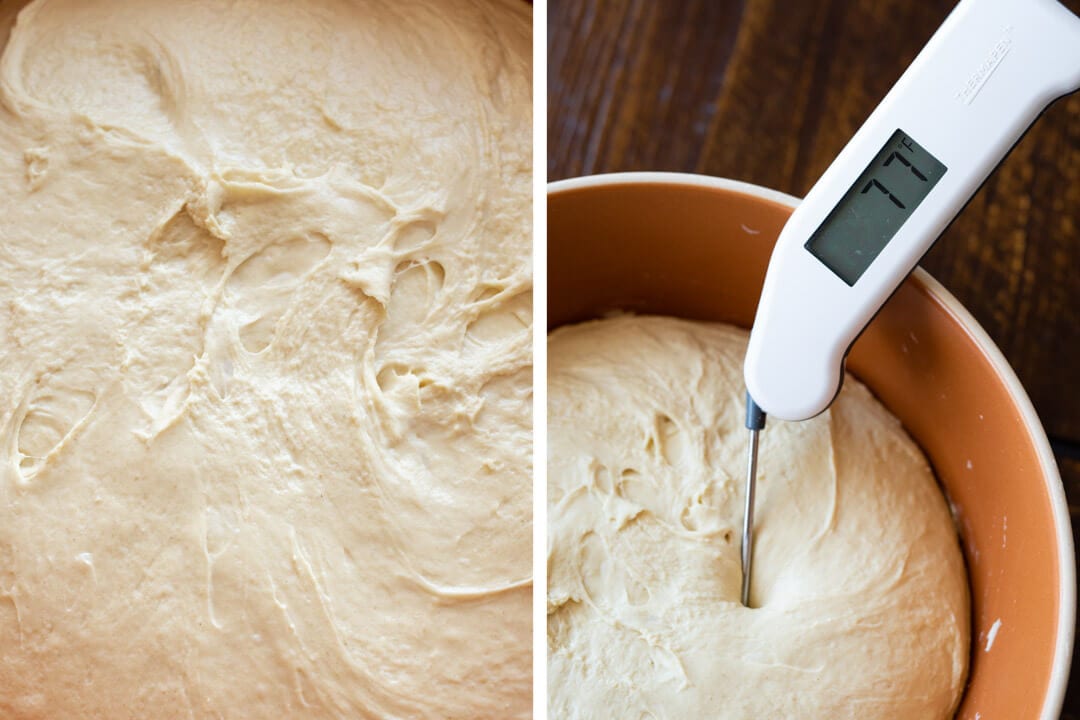
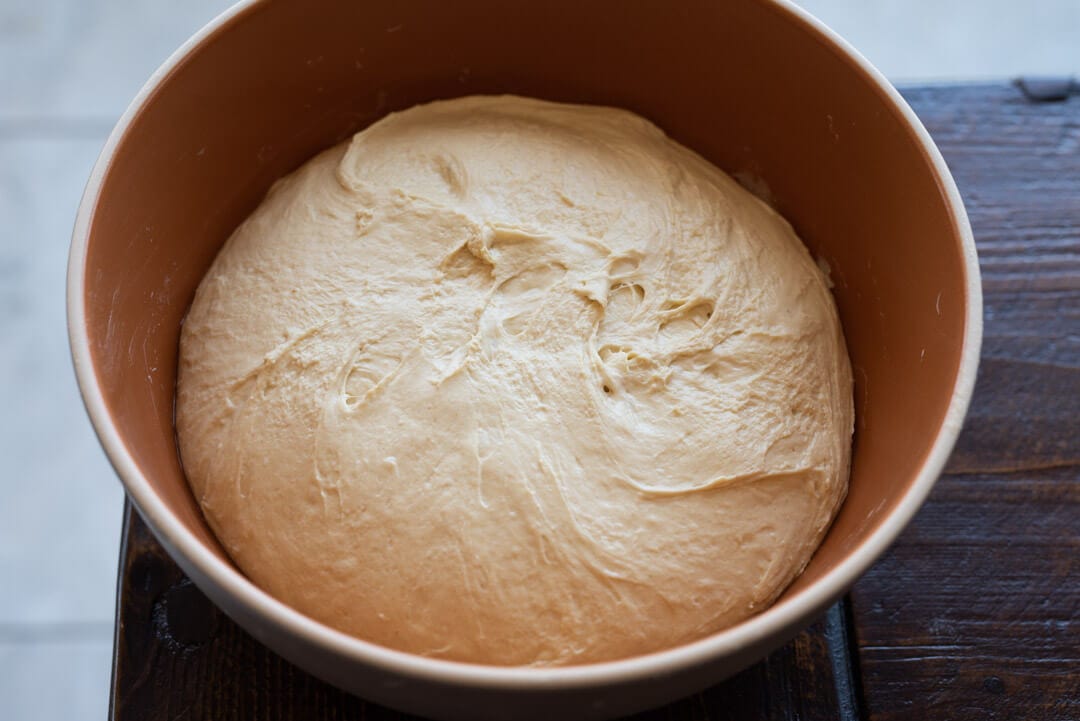
Transfer the dough to a tub or thick-walled bowl for bulk fermentation.
4. Bulk Fermentation – 1:20 p.m. to 4:50 p.m.
Perform a total of 5 sets of stretch and folds during the bulk. The first set is 15 minutes after the start of bulk, and the second set is 15 minutes after that. From there on, the remaining sets are 30 minutes apart. After the last set, let the dough rest for the remaining bulk fermentation time.
If you nailed the final dough temperature, and it’s kept fairly warm, the dough should be ready to divide after 3 hours and 30 minutes.
5. Divide & Preshape – 4:50 p.m.
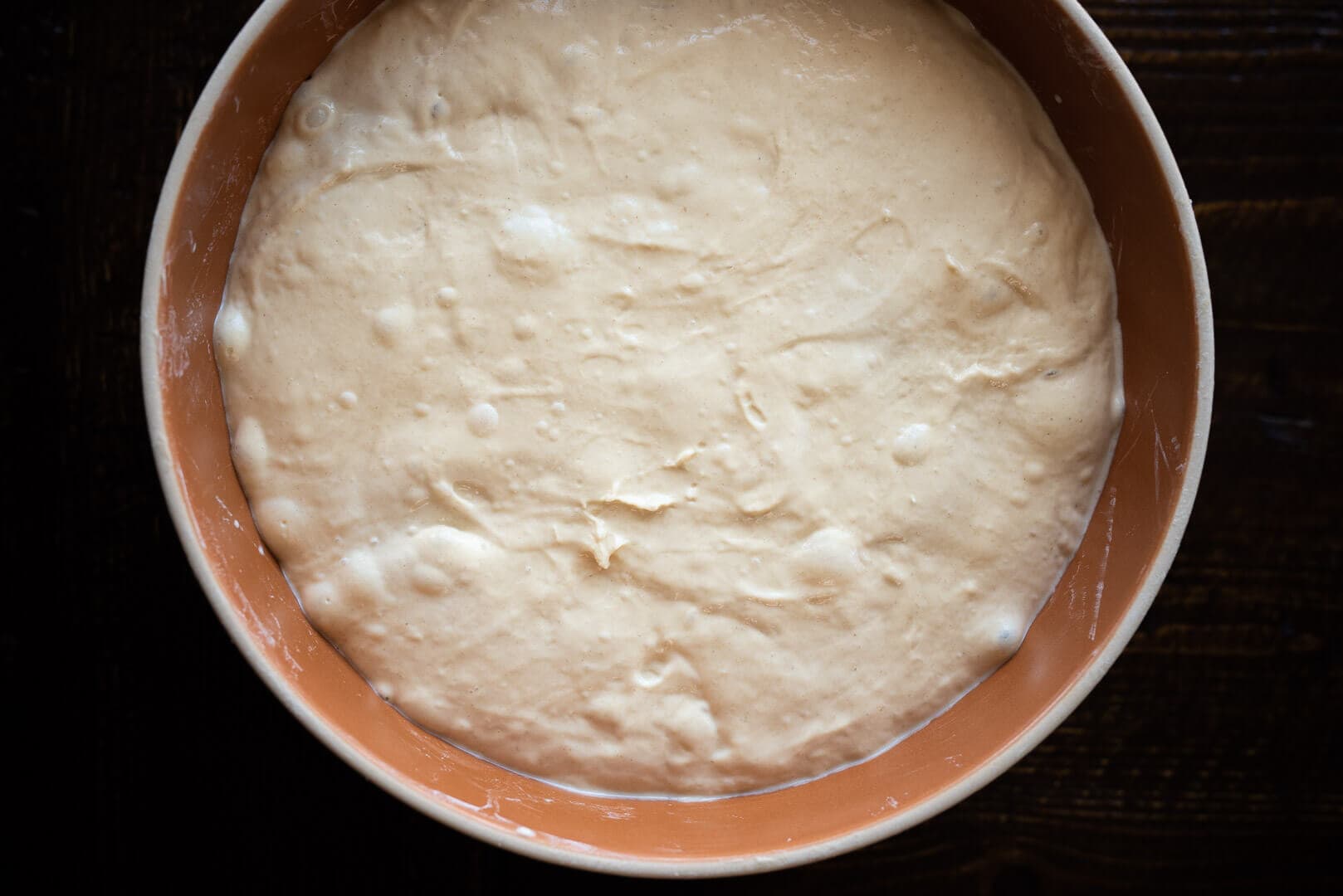
At the end of bulk, as seen below, the dough will have risen some (perhaps not as much as you might be accustom to), be smooth on top, and show signs of healthy fermentation. If you gently shake the bowl, the dough mass will jiggle. Dump the dough from the bulk container to a lightly floured work surface. The dough will be wet, sticky to the touch, and will likely want to spread some. Using well flour hands and a bench knife, divide the mass in half and shape each half into tight rounds. This can be challenging; use as much flour as needed and shape as tight as possible.
Let the dough rest for 15 minutes, uncovered. Keep an eye on the dough, if it starts to spread quickly, skip the remaining rest time and proceed directly to shaping.
6. Shape – 5:05 p.m.
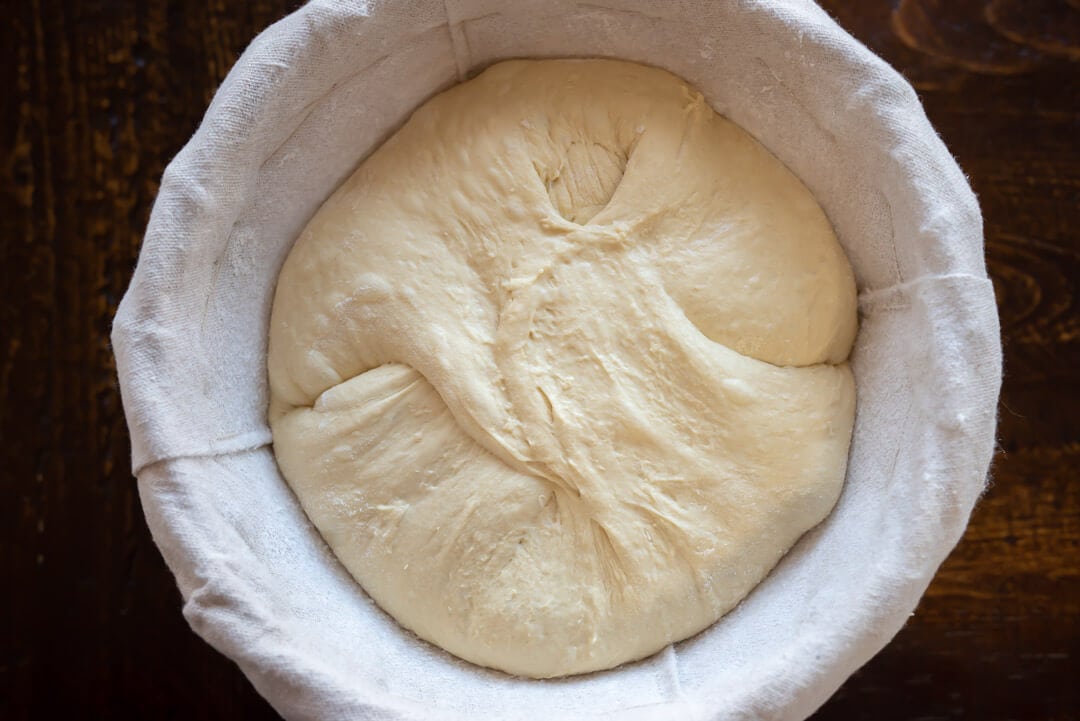
Liberally flour your shaping area and the top of your rested, and relaxed, rounds. Using a bench knife and your hand flip one round over. Fold the bottom up to the middle. Then fold each side, left and right, over to the other to form what looks like an open envelope in front of you. Then, grab the top and fold it up and down to about the middle. You can then flip this whole package over and use both hands to drag the dough down towards you as your pinky fingers create tension. If the dough needs more tension, slightly rotate the mass and continue to drag down with both hands. Repeat as necessary. Using your bench knife invert the round into a proofing basket liberally dusted with white rice flour. To encourage maximum rise the next day, be sure to shape each round tightly. After you place the shaped round in the basket, I found performing two “tucks” of the dough to help it keep shape (see above). Using wet or floured hands, grab the very side of the dough with two hands opposite each other and gently pull up and over to the center to seal. Rotate the boule and repeat the tucks at the opposite ends (you’ll end up with four flaps overlapping in the center).
7. Proof – 5:15 p.m. to 7:30 a.m. (the next day)
Cover each basket with plastic to prevent it from drying out as it proofs overnight. In my home fridge at 38°F (3°C), I proofed this dough for 14 hours.
8. Bake – Preheat oven at 6:30 a.m., Bake at 7:30 a.m.
I baked these boules on my Baking Steel in my oven (see my post on how to steam your home oven for baking), but you could also use a Dutch oven or combo cooker. I baked one round at a time, but you might be able to fit both on your baking surface.
Preheat your oven with baking stone/steel for one hour at 450°F (230°C).
Prepare a pizza peel and two pieces of parchment paper. Remove the dough from the fridge, uncover the baskets, and turn out the dough from the proofing basket onto the parchment that is resting on the pizza peel. Score the dough with a bread lame as desired, and load into your preheated oven by dragging in each piece of parchment holding the dough.
Bake for 20 minutes with steam. Then, remove the steaming pans from inside the oven (or remove the lid to your combo cooker) and bake for an additional 30-35 minutes, or until done, without steam in the oven.
Once fully baked, let the loaves cool on wire racks for at least one, preferably two, hours.
Conclusion
While there might be a few challenges in working with this dough, with practice it yields an outstanding einkorn sourdough bread. The result is a solid, flavor-laden loaf that is sure to delight. Due to the gluten properties of einkorn, you won’t achieve a tall rise out of this bread, but that’s beside the point — it’s all about flavor, texture, and nutrition here. The subtle, tang from natural fermentation paired with the warm, round taste of einkorn results in a truly memorable bread.
Crust
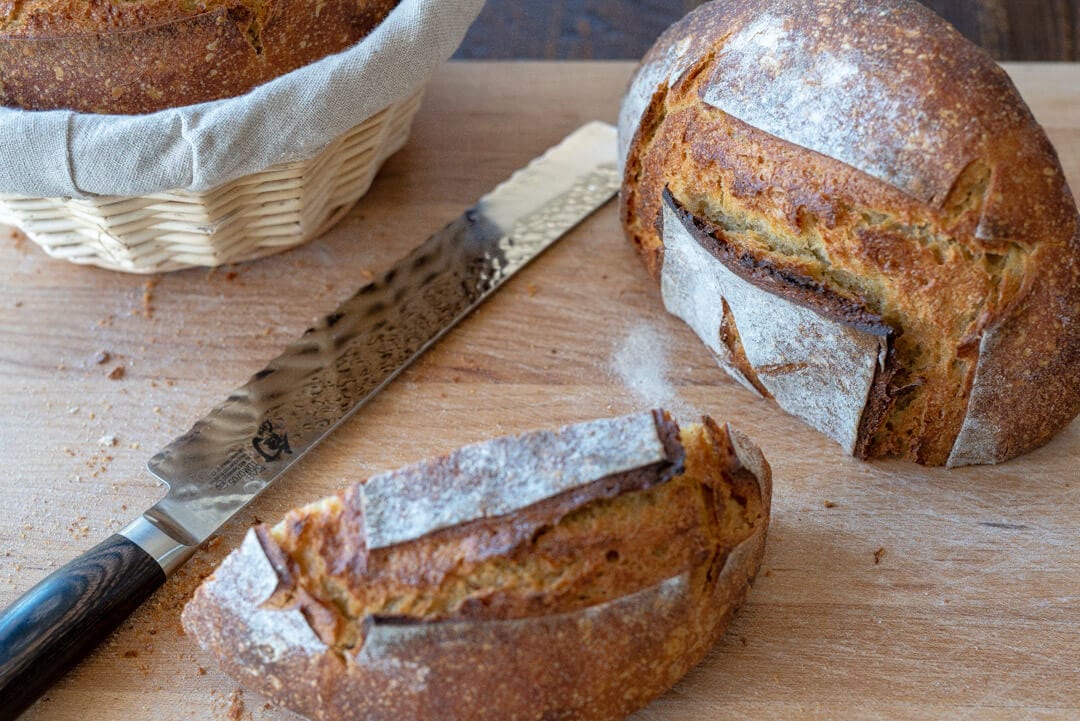
The crust is rugged and deeply colored, igneous even. It’s this kind of crust that has me reaching for the bottle of extra virgin olive oil each time I happen to walk by the cutting board. And to be honest, that happens a little too often on the day this bread is baked.
I like a heavy dusting of white rice flour in the proofing baskets to provide a little aesthetic contrast, a slight reprieve, to the well-colored exterior. The crust is always the first thing you see when you pick up a loaf of bread, and when you see one like this, it’s hard to resist the urge to cut—or even tear—forthwith.
Crumb & Taste
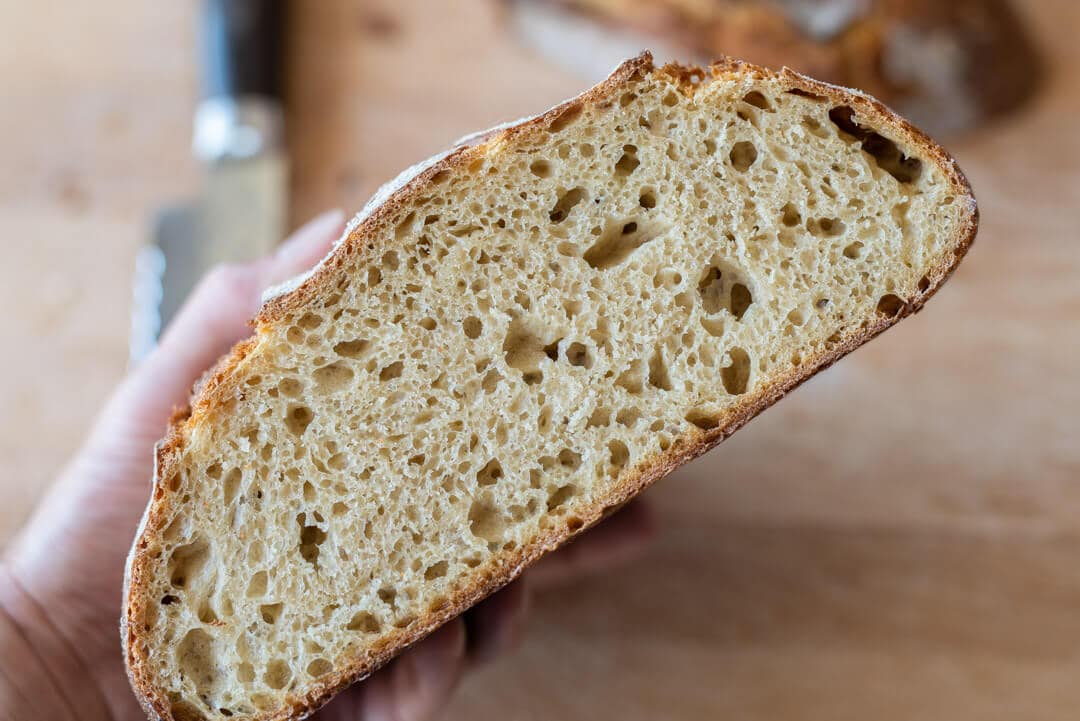
When well fermented, the interior is light and uniformly open. This is a substantial loaf of bread, but through proper fermentation each slice has levity to it, providing just the right amount of chew. The tender interior texture is rather surprising: even days after baking this bread seems to hold on to its moisture, retaining that tenderness and soft chew much longer than expected. Still, be sure to store your bread properly for maximum shelf life.
Thanks to the stiff levain and lengthy fermentation timeline this einkorn sourdough bread has just the slightest of tang at the end of each bite. This subtle sourness heightens your sense of taste, allowing the rich, yet sweet, the flavor of the grain to fully express itself. I would venture to say this bread ranks up there with some of the most flavorful I’ve made.
Thanks so much to Jovial for sponsoring the development of this einkorn recipe and for this post! As always, the opinions and content here are my own.
If you use this recipe, tag @maurizio on Instagram so I can take a look!
Einkorn Sourdough Bread FAQs
The dough is very sticking when mixing, how can I make this easier?
I find hand-mixing this dough in the bowl to be easiest. A dough whisk might help keep your hands clean during the initial stages of mixing. From there, keep your hand moist when doing folds in the bowl to prevent the dough from sticking. My recipe relies more on stretch and folds during bulk fermentation than strengthening the dough up front so don’t worry if the dough isn’t super smooth at mix-time.
The dough is hard to shape, what can I do?
While einkorn is high in protein, its gluten properties aren’t the same as modern wheat. This results in a dough that can be overly sticky and wet by the end of bulk fermentation. If you’re having trouble shaping, try reducing the hydration of the dough next time (see the section below for the formula at 70% hydration). This will help bring a lot of strength to the dough, making it more manageable during shaping.
Why doesn’t the dough rise when I bake it?
While there could be many causes for this, my initial guess is usually over-proofed dough. Try reducing the proof time in the fridge by 2-4 hours and see if this helps eke out more rise.
I’m not getting a nice ear when I score and bake, what gives?
This dough will not yield a super high ear (the area that lifts up on a loaf where it’s slashed). Other causes could be a dough that’s over proofed, not shaped tight enough, or simply not scored deep enough.
What’s Next?
If you’re looking for another large loaf, my Hop Miche, made with a dark, malty stout, has all the lovely qualities of a large loaf (keeping quality! Incredible crust! Delicate crumb!) but with a rich and earthy flavor.
Happy baking!
